Blogs
Practical Insights & Latest Happenings
Don’t miss out on the latest trends and info on SEO, search engines, social media, and more.
January 16, 2024
mothasim
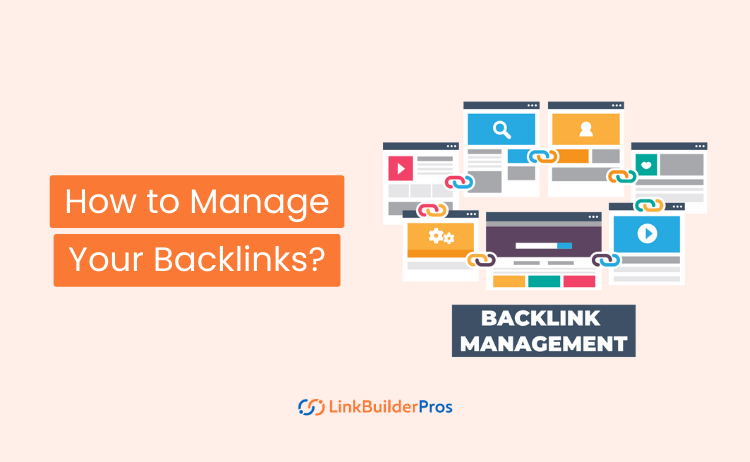
Gaining quality backlinks is just a part of your link building campaign; you need to learn how to manage your backlinks with tools and techniques so you can measure their performance in real time and upgrade your SEO strategy.
That means you need a backlink management guide that will allow you to track the progress and help level up your SEO. Without further ado, let’s get down to business!
Backlink management is about dealing with issues that affect your backlink profile, such as broken links, low-quality links, spammy links, or unnatural links. All of these can hurt your reputation and rating.
It’s also about getting the most out of your links. This includes improving your connections by contacting linking sites for better anchors, updating your material to meet the context of the link, and developing more link-worthy content to attract more high-quality links.
What’s more, you can have a robust backlink profile that supports your entire SEO strategy by efficiently managing your backlinks.
Here is what to know about backlink management:
In short, managing backlinks by building new good ones and monitoring current ones helps improve search visibility, authority, and traffic. It’s work but it pays off.
Managing your backlink profile is essential for several reasons. It helps to increase website visibility, improve search engine results, and drive organic visitors.
Here are the key reasons why managing your backlink profile is important:
More high-quality backlinks from authoritative external sources improve your domain authority in the eyes of Google and other search engines. This has the potential to directly enhance rankings and organic search traffic.
Backlinks make it easier for visitors to find and access your material, as well as expose your brand to new audiences. Managing them helps maximize your reach and awareness.
Proactive link building allows you to gain more quality backlinks than competitors in your space. Distinguishing your brand leads to more trust and site growth.
Backlink analysis allows you to detect and address any toxic, broken, or bad links that could impact your rankings or violate Google’s regulations. The importance of upkeep cannot be overstated.
Backlinks from trustworthy sites signal legitimacy and pass authority to your own domain. This improves conversion rates.
If properly cultivated, inbound links can survive for years. Even as algorithms evolve, the work done now continues to reap benefits in the future.
In short, clever backlink profile management offers ongoing benefits in terms of reaching customers, surpassing competition, and sustaining long-term growth. It is a wise digital investment.
Backlinks are still vital for search engine results now, just as they were in the beginning of the internet. Link metrics are measurements that assess the quality and authority of backlinks to a website. Understanding link metrics aids in determining the worth of backlinks.
Here are the key metrics to monitor in your link profile:
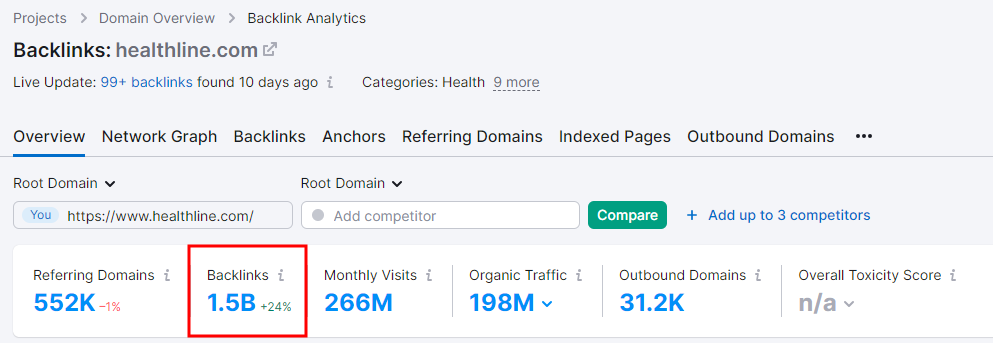
This means the total number of links from other websites to your website. Have more backlinks from quality websites to help search engines see you as an authority. Get links slowly over time rather than too fast.
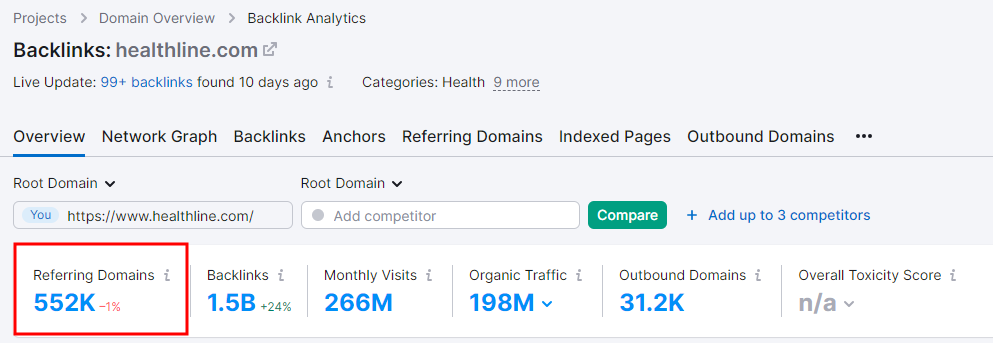
This refers to the amount of distinct websites that connect to you. Links should come from a variety of reliable websites, not just one or two. Variety indicates credibility.
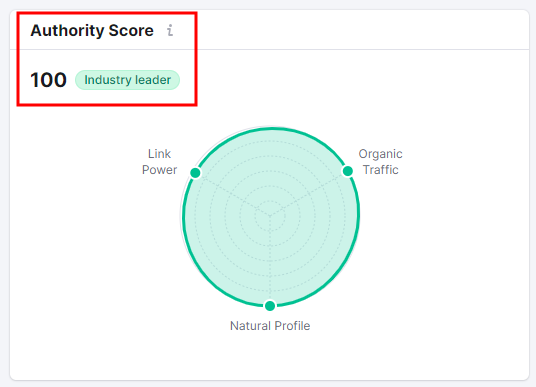
This is the authority score of sites giving you links. A higher rating means the website has more credibility. If an authoritative site links to you, it helps your own site’s authority and rankings.
We have a detailed blog on “How to Increase Your Domain Authority” that you can check out here.
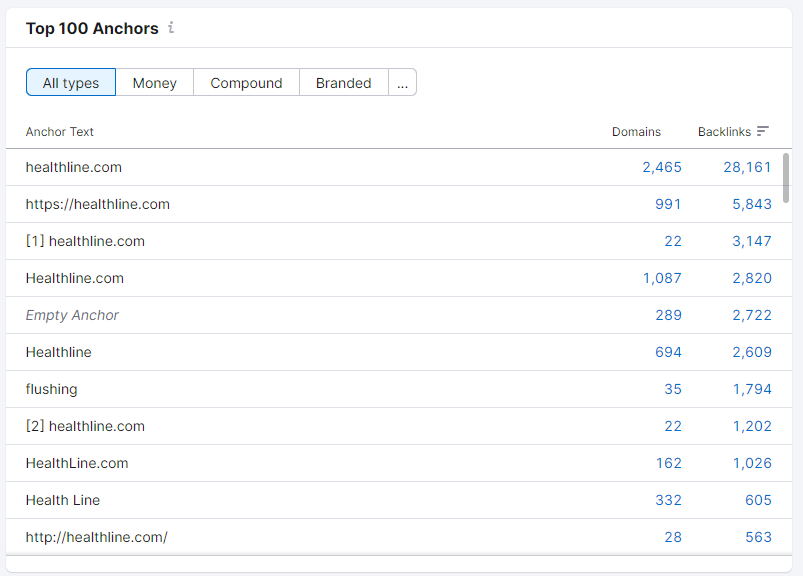
This is the actual text of links pointing to your site. You want a mix of anchor text with your brand, keywords, and URLs over time. Don’t over-optimize or it seems unnatural.
Where links point on external pages matter. Links higher on the homepage are more powerful than deep interior pages. But aim for logical, editorial links rather than paid homepage spots.
This tracks how fast you acquire new links. Steady, gradual growth in quality backlinks looks most real and natural. Be cautious of rapid spikes in link velocity.

These links result in “Page not found” errors and should be redirected or removed. They frustrate users and make your site seem neglected. Fix errors and do link maintenance.
Backlink management does not have to be a difficult or time-consuming activity. You might attempt the following simple steps and effective backlink management strategies:
A backlink audit is crucial for understanding the health and quality of the links pointing to your website. It involves analyzing, classifying, and identifying potentially harmful backlinks to maintain a strong online presence.
This involves using tools like Ahrefs, Moz, or SEMrush to obtain a comprehensive view of your website’s backlink profile. Let’s say you’re using Ahrefs:
For instance, if your website gained a sudden influx of low-quality links from unrelated websites, it might be a red flag.
Categorize your backlinks into different groups to better understand their nature and impact on your website’s SEO:
For example, a backlink from a reputable industry blog related to your niche would be classified as a natural/high-quality backlink. In contrast, links from link farms or unrelated forums might be considered toxic.
This step involves scrutinizing and identifying potentially harmful backlinks that could negatively impact your website’s SEO performance.
For instance, a backlink from a website flagged for malware or suspicious activities would be identified as a bad backlink. Similarly, an excessive number of links with the same anchor text from low-quality sources could raise concerns.
Here are some useful tips and techniques for effectively managing your website’s backlink profile:
Sometimes bad links from spammy or low-quality websites point to your site. These are called toxic backlinks. Toxic links can hurt your rankings and reputation.
Google has a Disavow Tool you can use. This tool tells Google: “These bad links are not my fault.” It asks Google not to count these links against your site.
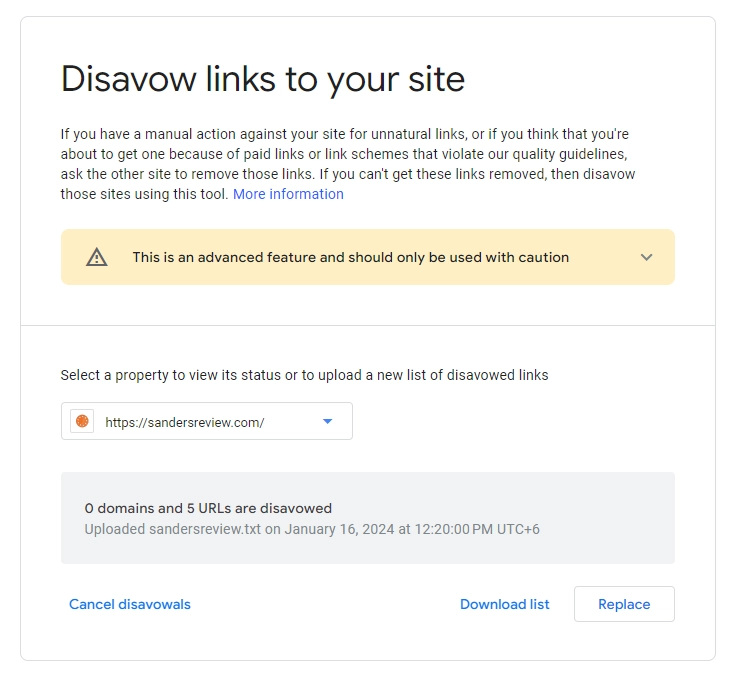
How to use it:
To disavow bad links using the Google Disavow Tool, start by accessing your Google Search Console account and navigating to the “Disavow Links” section under the “Links” menu.
Make sure you’ve selected the correct property for your website. Prepare a text file containing the URLs or domains you want to disavow, using the proper syntax.
Now upload the file through the Disavow Tool, review its contents, and confirm your submission. Monitor the status of your disavowal request over time, regularly checking for updates.
Don’t forget to exercise caution and use the tool only after attempting manual removal or outreach for link removal. Additionally, document reasons for disavowing each link and avoid disavowing links that might be beneficial.
This process helps maintain a healthy backlink profile and contributes to your site’s overall SEO integrity.
We have a detailed blog on “How to Remove Spam Backlinks” that you can check out here.
Broken links on a page appear when a URL no longer works, often leading to “Page Not Found” errors. Visitors dislike clicking broken links and they can negatively affect SEO if not fixed.
Tips to fix broken backlinks:
Check your profile each month to find incoming broken links as well. Regular broken link maintenance keeps a clean, credible site visitors trust and return to.
Ongoing backlink monitoring provides awareness of new links, lost links, and link issues. This helps swiftly address problems and pursue opportunities.
Consistently check backlinks using available tools:
Review backlink reports to identify:
Set calendar reminders to analyze backlinks every 1-2 months. Maintain an updated tracking spreadsheet of link numbers over time.
Regular backlink check-ins provide early warnings of issues and keep success metrics climbing through proactive link management.
You have to use backlink monitoring tools with alert systems that notify you when a backlink becomes broken or is removed.
Here are the steps to set up the alerts:
With Ahrefs:
With Semrush:
With Hexowatch:
By setting up these alerts, you get to enjoy a healthy link profile by being promptly notified of any lost or broken backlinks, allowing you to take immediate action to address the issues and maintain the quality of your backlink profile.
To check the authority of new backlinks, you can use tools such as Ahrefs’ Website Authority Checker, which provides a free tool to check the “authority” of any website based on the quality and quantity of its external backlinks.
The authority of a website is determined by factors such as the number of unique websites (referring domains) linking to it and the quality of these external backlinks. A higher number of referring domains and the quality of these domains can contribute to a website’s overall authority.
Additionally, Ahrefs’ Domain Rating (DR) is a good proxy by which to judge the relative quality of link prospects, as it looks at the quantity and quality of external backlinks to a website.
With tools like Ahrefs, you can assess the authority of new backlinks and make informed decisions about their impact on your overall link profile and authority.
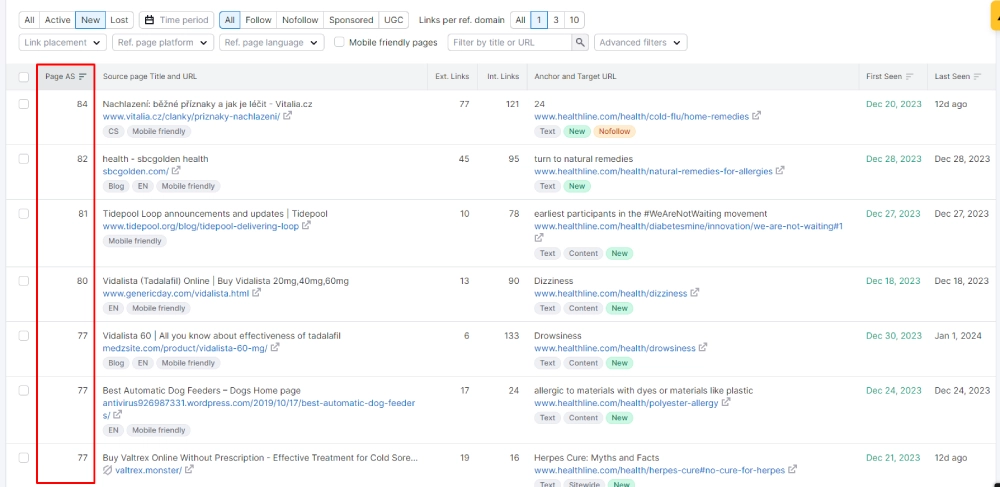
The concept of a dofollow to nofollow backlink ratio has been a topic of discussion in the SEO community. However, it’s important to note that there is no universally agreed-upon optimal ratio of dofollow to nofollow links. Here are some insights from the search results:
No Optimal Ratio:
Natural Link Profile:
Rule of Thumb:
In summary, while there is no specific recommended ratio of dofollow to nofollow links, it’s important to focus on building a natural and diverse link profile with a mix of both types of links. The emphasis should be on acquiring good, relevant, and natural links rather than fixating on a specific ratio.
The best way to earn backlinks long-term is to make genuinely useful content that sites want to reference. Focus on value, not link counts. Start with audience needs.
Do in-depth research to uncover meaningful problems people face. Turn findings into help guides, data studies, how-to videos, etc.
Characteristics of engaging, linkable content:
Promote your content through your own social channels to build initial interest. Reach out to relevant sites that could benefit their audience by linking to your asset.
Quality content marketers and journalists may organically feature without pitching if they discover your content searching for reporting or citations.
Focus efforts on continually producing new “linkbait” – things so inherently useful, sites link without you requesting. Building long-lasting resources earns sustainable links for years.
Anchor text refers to the clickable words in a link. For example, “click here” can link to your website. Optimizing anchor text helps search engines understand what each link is about.
You want a natural mix of anchor text in links to your site. These include:
When getting sites to link to you, aim for variety:
The goal is a balance of branded, generic, and keyword-rich anchor text across all your backlinks. This looks credible and helps search bots better categorize and index your website.
It’s crucial to regularly review the quality and relevance of your backlinks to understand how they impact your site’s performance in search results. After doing backlinks regularly monitor your ranks, and check the pages on which you did backlinks is their ranking improving or decreasing?
You can measure their impact by tracking metrics such as the number of backlinks, domain authority, and anchor text diversity. Tools like Aherfs, Moz, and Google Analytics can help monitor changes in organic traffic, keyword rankings, and domain authority, which provides valuable insights into the quality and impact of your backlinks.
By analyzing these metrics on a daily basis, you can make informed adjustments to your backlink strategy, leading to sustained positive impacts on your site’s overall performance.
Referral traffic, which usually comes from backlinks, is an important metric to monitor for inbound marketers. It describes the visitors who come to your website from other sites, without searching for you on Google.
When someone visits a link from a social network or website and ends up on another site, it’s recognized as referral traffic. By tracking referral traffic, you can gain insights into the valuable visitors being sent to your website from trusted domains.
This can also be relevant for SEO, as it contributes to improved brand exposure and recognition, better SEO through consistent backlinks, and the development of networking opportunities and future leads. Social media sites are some of the most valuable sources of referral traffic.
Therefore, it’s important to monitor and set alerts for lost or broken backlinks to ensure that your website maintains a healthy link profile, maximizing the potential for overall SEO success.
To request better anchors and update content, consider the following best practices:
By following these tips, you can effectively communicate with webmasters, request better anchors, and collaborate on content updates, fostering a positive and mutually beneficial relationship for backlink management.
Search engines like Google frequently update their ranking algorithms. These changes impact how links get valued for search visibility. Staying updated on algorithms helps create better link building strategies.
There are a few ways to stay informed:
As you learn about new algorithms, measure the possible effects on link signals:
Adapt your link building approach accordingly over time. Experiment to see impact. Staying up-to-date on changes allows proactive strategies aligned with current SEO standards. This helps search bots continue trusting your backlinks.
Here are some popular backlink management tools –
These tools offer various features such as backlink analysis, competitor monitoring, and link building, and they can be used to effectively manage and optimize backlink profiles.
Backlink management is a regular process that necessitates awareness, planning, and some SEO knowledge. Maintaining a clean and quality backlink profile may open the road for higher search engine results and a stronger online presence. Remember that in the fast-paced world of the internet, it’s not just about who you know, but also about who links to you.
Now that you know how to manage your backlinks, it’s time to dominate the SERPs!